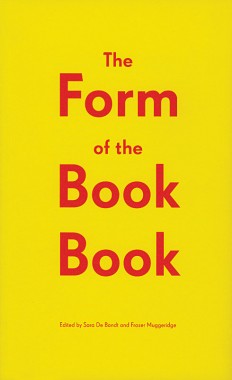
Sara De Bondt and Fraser Muggeridge, The Form of the Book Book
Softcover, 96 pp., offset 2/1, 140 x 230 mm
Edition of 1000
ISBN 978-0-9562605-1-2
Published by Occasional Papers
out of print
A collection of essays on book design by Catherine de Smet, James Goggin, Jenni Eneqvist, Roland Früh, Corina Neuenschwander, Sarah Gottlieb, Richard Hollis, Chrissie Charlton, Armand Mevis.
Armand Mevis, Calverts Printers, Catherine de Smet, Chrissie Charlton, Corina Neuenschwander, Criticism, Distribution, Fraser Muggeridge, James Goggin Jenni Eneqvist, Occasional Papers, Richard Hollis, Roland Früh, Sara De Bondt, Sarah Gottlieb, Typography
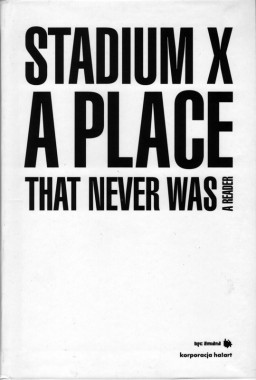
Joanna Warsza, Stadium X — A Place That Never Was
Softcover, 128 pp., offset 4/1, 135 x 195 mm
Edition of 500
ISBN 978-83-925107-6-5
Published by Laura Palmer Foundation
$20.00 ·
A mix of Socialist mausoleum, Aztec temple, and bunker system with a network of small gardens, along with a grid structure of endless market stalls — here is one of possible pictures of Socialist Realist ruin –- the 10th-Anniversary Stadium and the Jarmark Europa open-air market surounding it. After twenty years of a phantom-like existence in the middle of Warsaw, this expanse in 2008 became the construction site of a new national stadium. The book offers a selection of texts present ing a multi-faceted picture of that site’s deterioration and its bizarre existence as a ‘city within a city’. It pictures the area as a Land-Art piece and picturesque ruin, a primeval forest, a realm of precariousness and discount shopping, a work camp for archaeologists and botanists, a ‘Vietnamtown,’ a sonic phenomenon or architectural splendor. The reader also documents the series of site-specific art projects entitled The Finis sage of Stadium X curated by Joanna Warsza and provides them with a theoretical context.
The Stadium was built in 1955 from the rubble of a war-devastated, and was to preserve Communism’s good name for forty years. In the early 1990s it fell into ruin, being at the same time ‘revived’ by Vietnamese intelligentsia-cum-vendors and Russian traders, pioneers of capitalism. Jarmark Europa suddenly became the only multicultural site in the city, a storehouse of biographies and urban legends, as well as a major tourist attraction. The heterotopic logic of the place and its long-standing (non)presence in the middle of Warsaw brought about the series of art projects, and later this reader.
Over the course of time, the 10-th Anniversary Stadium which is now being erased form the map of Warsaw will likely become some distant planet, while the present publication, with the brilliant contributions from its authors, will attain — perhaps — the status of an unreal story about a place that, after all, never was.
—Daniel Miller, Frieze
Anda Rot ten berg, Art, Bar bara Sudnik-Wójcikowska, Ben jamin Cope, Cezary Polak, Claire Bishop, Criticism, Culture, Distribution, Ewa Majew ska, Grze gorz Piątek, Halina Galera, Joanna Warsza, Laura Palmer Foundation, Marek Ostrowski, Ngô Văn Tưởng, Pascal Nicolas-Le Strat, Pit Schultz, Roland Schöny, Sebas t ian Cichocki, Sport, Stach Szabłowski, Theory, Tomasz Stawiszyński, Warren Niesłuchowski
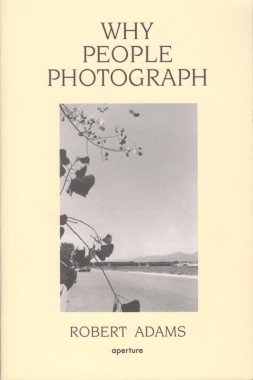
Robert Adams, Why People Photograph
Softcover, 189 pp., offset 1/1, 5.5 x 8.25 inches
Edition of 2000
ISBN 9780893816032
Published by Aperture
$15.00 ·
A now classic text on the art, Why People Photograph gathers a selection of essays by the great master photographer Robert Adams, tackling such diverse subjects as collectors, humor, teaching, money and dogs. Adams also writes brilliantly on Edward Weston, Paul Strand, Laura Gilpin, Judith Joy Ross, Susan Meiselas, Michael Schmidt, Ansel Adams, Dorothea Lange and Eugène Atget. The book closes with two essays on “working conditions” in the nineteenth- and twentieth-century American West, and the essay “Two Landscapes.” Adams writes: “At our best and most fortunate we make pictures because of what stands in front of the camera, to honor what is greater and more interesting than we are.”
Ansel Adams, Aperture, Criticism, DAP, Dorothea Lange, Edward Weston, Eugène Atget, Judith Joy Ross, Michael Schmidt, Paul Strand, Photography, Robert Adams, Susan Meiselas, Theory
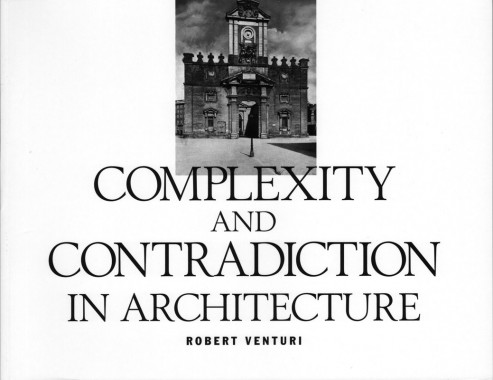
Robert Venturi, Complexity And Contradiction In Architecture
Softcover, 136 pp., offset 1/1, 11 x 8.5 inches
Edition of 5000
ISBN 9780870702822
Published by MoMa
$20.00 ·
First published in 1966, and since translated into 16 languages, this remarkable book has become an essential document of architectural literature. A “gentle manifesto for a nonstraightforward architecture,” Venturi’s Complexity and Contradiction in Architecture expresses in the most compelling and original terms the postmodern rebellion against the purism of modernism. Three hundred and fifty architectural photographs serve as historical comparisons and illuminate the author’s ideas on creating and experiencing architecture.
Architecture, Arthur Drexler, Criticism, DAP, MoMa, Robert Venturi, Vincent Scully
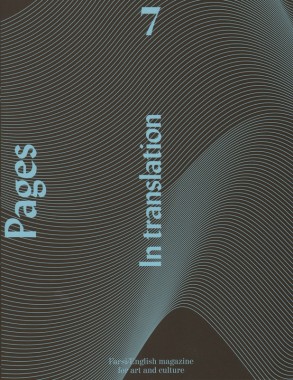
Pages 7, In Translation
Softcover, 88 pp., offset 1/1, 200 x 260 mm
English and Farsi
Edition of 2000
ISSN 1583-3165
ISBN 978-90-5973-099-1
Published by Pages
$20.00 ·
This is the seventh annual issue of Pages, a publication that serves as a public discourse between the academic community in the West and Iran. The editors of Pages were inspired to scrutinize the various aspects of translation because they confront it with every issue of their journal. “There is clearly no such thing as a perfect substitute in translation,” the editors write. “There are instead displacements and interpretations, which remain nevertheless within the limits of the text.” An instance of cultural practice and political agency, translation does more than create a space between languages or among cultures. An innovative look at how translation affects the spatial and political arrangements of public and private spaces of cities, as communal or individual identities, in representations of state media, and in artistic practice itself.
Afarin Azad, Art, Babak Afrassiabi, Criticism, Culture, Nasrin Tabatabai, Pages, RAM, Steve Rushton
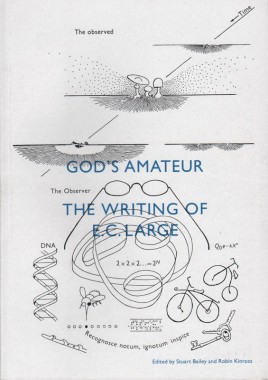
Stuart Bailey and Robin Kinross, God’s amateur: the writing of E.C. Large
Softcover, 96 pp., offset 3/1, 170 x 240 mm
Edition of 2000
ISBN 978-0-907259-38-1
Published by Hyphen Press
$20.00 ·
A book of and about E.C. Large, which contains a selection of his shorter writings — travel essays, reportage, reveries, reviews, critiques, autobiographical pieces — and which reveals the extent of his achievement. These show a notably exact writer, with sane no-nonsense views, and yet with great imagination. Some unpublished texts are shown in facsimile. Also here is a bibliography of his published writings (both ‘literary’ and scientific), and an essay by Stuart Bailey, which sees his work with present-day eyes.
Criticism, E.C. Large, Hyphen Press, PAP, Robin Kinross, Stuart Bailey
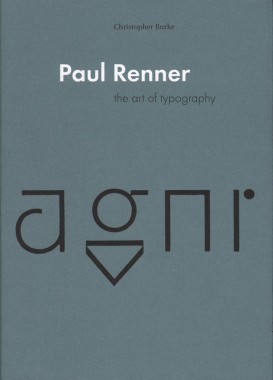
Christopher Burke, Paul Renner: the art of typography
Softcover, 224 pp., offset 4/1, 170 x 240 mm
Edition of 2000
ISBN 978-0-907259-12-1
Published by Hyphen Press
$35.00 ·
German culture in the twentieth century moved quickly and intensely, bound up with the politics of the country. Paul Renner (1878–1956) lived and worked through constituent episodes of this history, both embodying the patterns of his times and providing a critical commentary on them. In this book Christopher Burke provides the first extended account of an essential and still underrated figure.
Beginning his career in the thick of the Munich cultural renaissance, Paul Renner worked as a ‘book artist’, applying values he had learnt as a painter to this everyday item of multiple production. An early and prominent member of the Deutscher Werkbund, he was committed to the values of quality in design, always tempered by a certain sobriety of attitude and style. In the 1920s Renner engaged with the radical modernism of that time, briefly in Frankfurt, and then in a more extended phase at the printing school at Munich. Under Renner’s leadership, and with teachers such as Georg Trump and Jan Tschichold, the school produced work of quiet significance. In those years Renner undertook the design of the now ubiquitous typeface Futura. Christopher Burke’s analysis of the design process reveals the characteristic Renner approach: he took up with current tendencies, but through an extended process of finely judged development, helped to deliver a product that has long-lasting quality. In the Nazi seizure of power of 1933, Renner was dismissed from his teaching post — in days recounted here in dramatic detail — and entered a state of ‘inner emigration’. Burke’s account of the Nazi years shows Renner negotiating events with dignity. After 1945, Renner lived in retirement, but entered public discussion of design issues as a voice of experience and sanity.
Paul Renner is a work of discovery. As part of its fresh narrative and analysis, it includes much new illustrative material and the first full bibliography of Renner’s writings.
Christopher Burke, Criticism, Georg Trump, Hyphen Press, Jan Tschichold, PAP, Paul Renner, Theory, Typography
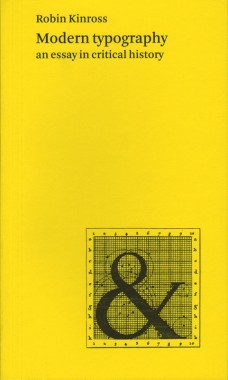
Robin Kinross, Modern typography: an essay in critical history
Softcover, 272 pp., offset 4/2, 125 x 210 mm
Edition of 2000
ISBN 978-0-907259-18-3
Published by Hyphen Press
$27.00 · out of stock
A brisk tour through the history of Western typography, from the time (c.1700 in France and England) when it can be said to have become ‘modern’. A spotlight is directed at different cultures in different times, to trace the developments and shifts in modern typography. Attention is given to ideas, to social context, and to technics, thus stepping over the limited and tired tropes of stylistic analysis.
This history of typography starts with the early years of the Enlightenment in Europe, around 1700. It was then that typography began to be distinct from printing. Instructional manuals were published, a record of the history of printing began to be constructed, and the direction of the printing processes was taken up by a new figure: the typographer. This starting point gives the discussion a special focus, missing from existing printing and design history. Modern typography is seen as more than just a modernism of style. Rather it is the attempt to work in the spirit of rationality, for clear and open communication. This idea is argued out in the introductory chapter.
The chapters that follow trace the history of typography up to the present moment. Different cultures and countries become the focus for the discussion, as they become significant. In the nineteenth century, Britain provides the main context for modern typography. In the twentieth century, the USA and certain continental European countries are prominent. Kinross provides concise accounts of modernist typography in Central Europe between the wars and in Switzerland in the 1950s and 1960s. Traditionalist typography in the USA, Britain, Germany and the Low Countries is also discussed sympathetically. A concluding chapter considers ‘modern typography’ in the light of the social, political and technical changes of the recent period.
Criticism, Hyphen Press, PAP, Robin Kinross, Theory, Typography
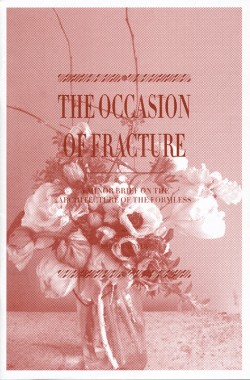
Keith Bormuth, The Occasion of Fracture
Softcover, 28 pp., offset 1/1, 160 x 240 mm
Edition of 500
Published by Keith Bormuth
$10.00 ·
Keith Bormuth’s The Occasion of Fracture traces the notion that media fulfills itself in a phatic relationship to knowledge. Following a ghost image of Reyner Banham’s seminal text on Los Angeles, Bormuth melds the on-screen laughter of the 1940s Hollywood star Irene Dunne with the show Gossip Girl, F. Scott Fitzgerald’s posthumously published The Crack Up, and the cameo appearance by Georges Bataille as a priest in Jean Renoir’s film Partie de Campagne. Composed in 11 themes, the text seeks to fracture the semblance images have as things.
Albert Reis, Art, Blair Waldorf, Chuck Bass, Criticism, Dawn Aragon, Distribution, F. Scott Fitzgerald, Georges Bataille, Guy Debord, Irene Dunne, Jean Renoir, Karl Kraus, Keith Bormuth, Manhab Renyer, Reyner Banham, Serena van der Woodson, Theory
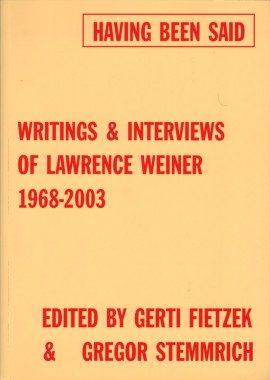
Lawrence Weiner, Having Been Said: Writings & Interviews Of Lawrence Weiner 1968-2003
Softcover, 488 pp., offset 1/1, 170 x 240 mm
Edition of 2000
ISBN 9783775791946
Published by Hatje Cantz
out of print
Lawrence Weiner’s art uses language in reference to materials. Language itself is a material and at the same time a means of presentation of his work. Weiner evolved this approach in the context of the Conceptual art of the late 60s, yet he does not see his own work as “conceptual.” The “space” he works within is the entire cultural context, and his works are associated with various different media and forms of presentation: books, posters, videos, films, records, drawings, multiples, installations indoors and outdoors, and more. Since his earliest days as a professional artist, Weiner has given written and verbal expression to questions concerning his work and its context. These utterances — statements, interviews, lectures and conference contributions — have been collected together in this publication for the first time, and ordered chronologically. Taken as a whole they afford an insight both into a complex individual biography and into the wider development of art and culture and the challenge that this entails.
Art, Criticism, DAP, Gerti Fietzek, Gregor Stemmrich, Hatje Cantz, Lawrence Weiner, Theory
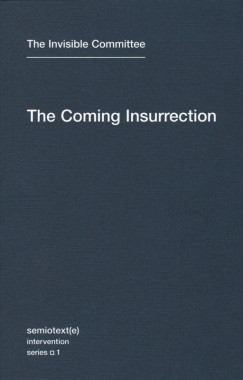
The Invisible Committee, The Coming Insurrection
Softcover, 136 pp., offset 1/1, 4.5 x 7 inches
Edition of 2000
ISBN 978-1-58435-080-4
Published by Semiotext(e)
$13.00 ·
Thirty years of “crisis,” mass unemployment, and flagging growth, and they still want us to believe in the economy…We have to see that the economy is itself the crisis. It’s not that there’s not enough work, it’s that there is too much of it.
—from
The Coming Insurrection
The Coming Insurrection is an eloquent call to arms arising from the recent waves of social contestation in France and Europe. Written by the anonymous Invisible Committee in the vein of Guy Debord — and with comparable elegance — it has been proclaimed a manual for terrorism by the French government (who recently arrested its alleged authors). One of its members more adequately described the group as “the name given to a collective voice bent on denouncing contemporary cynicism and reality.” The Coming Insurrection is a strategic prescription for an emergent war-machine to “spread anarchy and live communism.”
Written in the wake of the riots that erupted throughout the Paris suburbs in the fall of 2005 and presaging more recent riots and general strikes in France and Greece, The Coming Insurrection articulates a rejection of the official Left and its reformist agenda, aligning itself instead with the younger, wilder forms of resistance that have emerged in Europe around recent struggles against immigration control and the “war on terror.”
Hot-wired to the movement of ‘77 in Italy, its preferred historical reference point, The Coming Insurrection formulates an ethics that takes as its starting point theft, sabotage, the refusal to work, and the elaboration of collective, self-organized forms-of-life. It is a philosophical statement that addresses the growing number of those — in France, in the United States, and elsewhere — who refuse the idea that theory, politics, and life are separate realms.
Reviews
“…without a doubt the most thought-provoking radical text to be published in the past ten years. It deserves to be read and discussed.”
—Daniel Miller, New Statesman
“Any book indirectly responsible for massive raids involving helicopters and anti-terrorist police, a splenetic Fox News broadcast and an impromptu book-reading at a Barnes & Noble bookshop in New York (also attended by the police) must have something going for it. And so it is with The Coming Insurrection, the kind of political pamphlet last fashionable in the 17th century (and perhaps for a period in the 1960s and ‘70s).”
—Nina Power, Frieze Magazine
“I am not calling for a ban on this book. It’s important that you read this book. [...] And let me tell you something: Don’t dismiss these people. Don’t dismiss them.”
—Glenn Beck, Fox News/Glenn Beck Program
Criticism, MIT Press, Semiotexte, The Invisible Committee, Theory
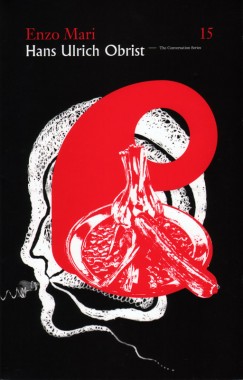
Hans Ulrich Obrist and Enzo Mari, The Conversation Series 15
Softcover, 88 pp., offset 4/1, 135 x 210 mm
Edition of 5000
ISBN 9783865604019
Published by Walther König
$25.00 ·
Volume 15 of
The Conversation Series features a riveting dialogue between series editor and cultural catalyst Hans Ulrich Obrist and the renowned Italian designer Enzo Mari. More concerned with theoretical issues in design than commercial success, Mari is one of the most thoughtful and intellectually provocative designers of the late twentieth century. His work as a product and furniture designer, as well as a writer, teacher and artist, has proved influential both to his peers and to younger generations. In this volume, Mari discusses his iconic designs for cutting-edge production houses Danese, Olivetti and Castelli, his experience of the contradictory aspects of postwar Italy and his unique take on the design trends of the 1960s and 1970s.
Enzo Mari was born in 1932 in Novara, Italy. He has most recently completed a series of tubular aluminum chairs for Vienna’s Gebrüder Thonet and a collection for the Japanese home store Muji.
Art, Criticism, DAP, Enzo Mari, Hans Ulrich Obrist, Walther König
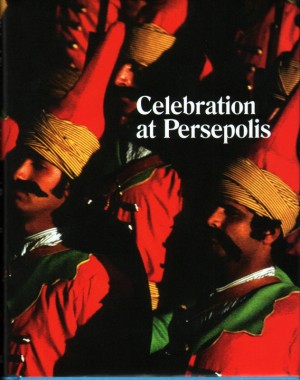
Michael Stevenson, Celebration at Persepolis
Hardcover, 64 pp., offset 4/1, 125 x 160 mm
Edition of 5000
ISBN 978-3-905829-48-8
Published by JRP|Ringier/Arnolfini
$19.00 ·
Described as an “anthropologist of the avant-garde,” Michael Stevenson investigates the mythology that surrounds renowned and controversial events which have been significant in the spheres of both art and politics.
Stevenson revisits the site of an infamous week-long party held in 1971 by the Shah of Iran among the ruins of the ancient Persian city of Persepolis. Reconstructing part of the temporary architecture built for the celebrations (itself now a ruin), Stevenson looks at this pivotal moment in Iranian history which led toward the subsequent cultural revolution.
This publication is part of the series of artists projects edited by Christoph Keller. Personally selected by Keller, for Textfield, as one of his top five from the series.
Arnolfini, Art, Christoph Keller, CK editions, Criticism, Culture, DAP, Elisa Kay, JRP|Ringier, Martin Clark, Michael Stevenson, Nav Haq












